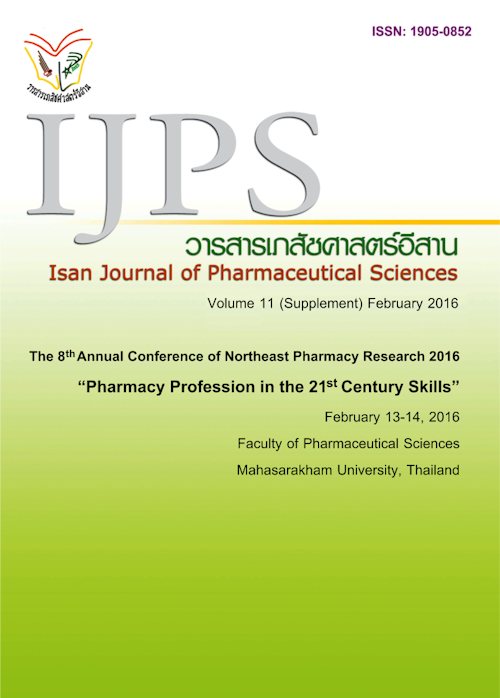Risk of Cardiovascular Adverse Events in Thai Patients with Concomitant Use of Clopidogrel and Omeprazole
Main Article Content
Abstract
Introduction: Concomitant use of clopidogrel and omeprazole may reduse on antiplatelet activity of clopidogrel, however the controversy regarding to the clinical outcomes still exists, particularly in Thai populations who concomitantly use both drugs. Objective: This study aims to assess the risk of cardiovascular adverse events associated with concomitant use of clopidogrel and omeprazole in Thai ST-elevation myocardial infarction (STEMI) patients who underwent percutaneous coronary intervention (PCI). Methods: A retrospective cohort study was conducted in STEMI patients who newly underwent PCI and received dual antiplatelet therapy (aspirin 81-325 mg and clopidogrel together with or without omeprazole). The data were collected at Queen Sirikit Heart Center of the Northeast of Thailand during January 2007 to December 2012. The primary outcomes were the occurrence of major adverse cardiovascular events (MACE) which occurred during the 1st and 12th month after initiation of dual antiplatelet therapy. Results: Of 389 patients, there were divided into clopidogrel plus omeprazole group (237 patients, exposure group) and clopidogrel alone group (152 patients, non-exposure group). Considering the combined end point, we found that the exposure group had a significantly higher rate of MACE than those in non-exposure group (14.3%vs.6.6%; adjusted HR 2.77; 95%CI, 1.20–6.43). The exposure group also had a significantly higher rates of old vessel revascularization than those in non-exposure group (7.6%vs.3.9%; adjusted HR 3.31; 95%CI, 1.02-10.79). Conclusion: Our data suggested that concomitantly use of clopidogrel with omeprazole in Thai STEMI patients who underwent PCI was associated with the higher risk of cardiovascular adverse events, in particular the risk of old vessel revascularization compared with clopidogrel use alone.
Article Details
In the case that some parts are used by others The author must Confirm that obtaining permission to use some of the original authors. And must attach evidence That the permission has been included
References
Abraham Neena S., Mark A. Hlatky, Elliott M. Antman, Deepak L. Bhatt, David J. Bjorkman, Craig B. Clark, et al. ACCF/ACG/AHA 2010 Expert Consensus Document on the Concomitant Use of Proton Pump Inhibitors and Thienopyridines: A Focused Update of the ACCF/ACG/AHA 2008 Expert Consensus Document on Reducing the Gastrointestinal Risks of Antiplatelet Therapy and NSAID Use : A Report of the American College of Cardiology Foundation Task Force on Expert Consensus Documents.
Abraham Neena S.Prescribing proton pump inhibitor and clopidogrel together: current state of recommendations. CurrOpinGastroenterol. 27:558–564 Circulation. 2010;122:2619-2633.
Charlot Mette, Erik L Grove, Peter Riis Hansen, Jonas B Olesen, Ole Ahlehoff, Christian Selmer.Et al. Protonpumpinhibitor use and risk of adverse cardiovascular events in aspirin treated patientswith first time myocardial infarction: nationwide propensity score matched study. BMJ.2011;342:d2690.
Gilard M, Arnaud B, Le Gal G, Abgrall JF, Boschart J. Influence of omeprazole on the antiplatelet action of clopidogrel associated with aspirin. J Am CollCardiol. 2008;51:256–60.
Goldstein, J. A., Ishizaki, T., Chiba, K., de Morais, S. M., Bell, D., Krahn, P. M. and Evans, D. A. Frequencies of the defective CPY2C19 alleles responsible for the mephenytoin poor metabolizer phenotype in various Oriental, Caucasian, Saudi Arabian and American black populations. Pharmacogenetics. 1997;7:59-64.
Harrison Robert W. & Kenneth W. Mahaffey. Clopidogrel and PPI Interaction: Clinically Relevant or Not? CurrCardiol Rep.2012;14:49–58.
Ho P. Michael, Thomas M. Maddox,Li Wang, et al. Risk of Adverse Outcomes Associated With Concomitant Use of Clopidogrel and Proton Pump Inhibitors Following Acute Coronary Syndrome. JAMA. 2009;301(9):937-944.
Hsiao Fei-Yuan 1, C. Daniel Mullins, Yu-Wen Wen, Weng-Foung Huang, Pei-Fen Chen5, Yi-Wen Tsai. Relationship between cardiovascular outcomes and proton pump inhibitor use in patients receiving dual antiplatelet therapy after acute coronary syndrome. pharmacoepidemiology and drug safety. 2011;20: 1043–1049.
Juurlink David N., Tara Gomes, Dennis T. Ko, Paul E. Szmitko, Peter C. Austin, Jack V. Tu, et al. A population-based study of the drug interaction between proton pump inhibitors and clopidogrel. CMAJ 2009;180(7):713-8.
Kushner Frederick G., Mary Hand, Sidney C. Smith, Jr, Spencer B. King, III, et al. 2009 Focused Updates: ACC/AHA Guidelines for the Management of Patients With ST-Elevation Myocardial Infarction (Updating the 2004 Guideline and 2007 Focused Update) and ACC/AHA/SCAI Guidelines on Percutaneous Coronary Intervention (Updating the 2005 Guideline and 2007 Focused Update). JAmCollCardiol. 2009;54;2205-2241.
Levine Glenn N., Eric R. Bates, James C. Blankenship, Steven R. Bailey, John A. Bittl, BojanCercek, et al. 2011 ACCF/AHA/SCAI Guideline for Percutaneous Coronary Intervention A Report of the American College of Cardiology Foundation/American Heart Association Task Force on Practice Guidelines and the Society for Cardiovascular Angiography and Interventions. Circulation. 2011;124:e574-e651.
Lin C.F., Shen L.J., Wu F.L., Bai C.H., Gau C.H. Cardiovascular outcomes associated with concomitant use of clopidogrel and proton pump inhibitors in patients with acute coronarysyndrome in Taiwan. Br J ClinPharmacol. 2012;74:5. 824–834.
Rassen Jeremy A., Niteesh K. Choudhry, Jerry Avorn, Sebastian Schneeweiss. Cardiovascular Outcomes and Mortality in Patients Using Clopidogrel With Proton Pump Inhibitors After Percutaneous Coronary Intervention or Acute Coronary Syndrome. Circulation. 2009;120:2322-2329.
RossiniRoberta, DavideCapodanno, Giuseppe Musumeci, CorradoLettieri, NikolozLortkipanidze, Michele Romano, et al. Safety of clopidogrel and proton pump inhibitors in patients undergoing drug-eluting stent implantation. Coronary Artery Disease.2011, 22:199–205.
Stockl Karen M.,Lisa Le, Armen Zakharyan, Ann S. M. Harada, Brian K. Solow, Joseph E. Addiego, et al. Risk of Rehospitalization for Patients Using Clopidogrel With a Proton Pump Inhibitor. Arch Intern Med. 2010;170(8):704-710.
Sukasem Chonlaphat, RamaimonTunthong, MontriChamnanphon et al. CYP2C19polymorphisms in the Thai population and the clinical response to clopidogrel in patients with atherothrombotic-risk factors. PharmgenomicsPers Med. 2013; 6: 85–91.
Tassaneeyakul Wichittra, WerawathMahatthanatrakul, KanokpornNiwatananun, et al. CYP2C19 Genetic Polymorphism in Thai, Burmese and Karen Populations. Drug MetabPharmacokinet.2006 Aug;21(4):286-90.
US Food and Drug Administration. Early Communication about an Ongoing Safety Review of clopidogrel bisulfate (marketed as Plavix) [online]. Available from URL: http://www.fda.gov/Drugs/DrugSafety/PostmarketDrugSafety-InformationforPatientsandProviders/DrugSafetyInformationforHeathcareProfessionals/ucm079520.htm [Accessed 31 July 2012]
US Food and Drug Adminstration. Information for healthcare professionals: update to the labeling of clopidogrel bisulfate (marketed as Plavix) to alert healthcare professionals about a drug interaction with omeprazole (marketed as Prilosec and Prilosec OTC) [online]. Available from URL: http://www.fda.gov/Drugs/DrugSafety/PostmarketDrugSafetyInformationforPatientsandProviders/DrugSafetyInformationforHeathcareProfessionals/ucm190787.Htm [Accessed 31 July 2012]


